Chania is the second largest city and the former capital of the island of Crete, famous for its romantic old harbor and the narrow alleys of the Old Town.
Chania attracts tourists by its beauty. Its vivid history has been influenced by the Turks and the Venetians, which is still very evident today. Moreover, the beautiful beaches are an important addition to the character of the city.
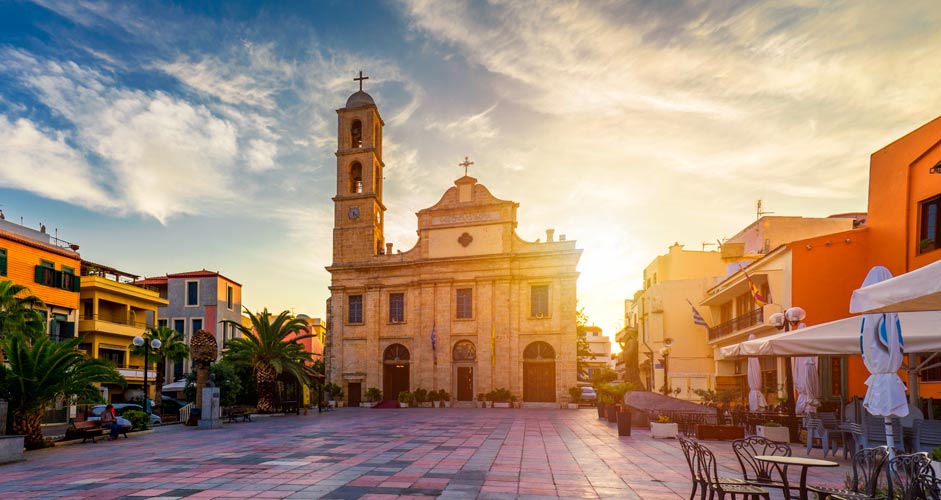
Where to stay in Chania
Chania has a good selection of accommodation for everyone’s taste and needs, ranging from large resorts in e.g. Agia Marina or Platania, to small, romantic Boutique hotels and private apartments in the Old Town.
When staying near the center, the best location is in the Old Town or in, for example, the Splantzia district.
Prices and availability vary seasonally. Compared to, for example, Heraklion, there’s a better selection of cheap hostels available - and with lower prices. As a rule of thumb, the farther away from the center or the Old Town, the lower the price. Like everywhere in Greece, the prices in Crete are affected by the season at hand.
The history of Crete in a nutshell
In Crete, there are signs of habitation ever since the Stone Age. Due to its strategic location, Crete has been an important island in the Mediterranean. In order to understand the unique island and its people, you need to understand the basics of its history. The vivid past is evident in the culture and identity of the island still today.
Crete has been ruled by the Venetians, the Ottomans as well as pirates. On the other hand, the Goths, the Slavs and the Arabs have tried to conquer it. They’ve also had to battle against their own, the Greeks, and eventually the isle was integrated to Continental Greece in 1913. Moreover, Crete has been sold twice to the Egyptians.
Chania, which was known as Cydonia in the Minoan era, has remained surprisingly original - in spite of being occupied by the Germans during the Second World War. Nor have the strong urbanization, modernization or the several conquerors been able to change the city’s character.
Chania beaches
Chania and its surroundings are lined with countless beaches, famous for the incredible views and clear blue and turquoise waters.
In general, the blue flagged beaches are the best and the cleanest beaches in Chania and the whole Crete. To avoid congestion especially during the peak seasons, you may want to go to the beach in the morning, or in the afternoon as the heat of the day fades away into the night.
It is also good for tourists to acknowledge that especially the finest sandy beaches attract loggerhead sea turtles (Caretta Caretta) to lay their eggs into the sand from May to September. If you see protected or otherwise marked nests in the sand, they should be left alone.
In the evening and at night, some beaches may be banned from noise and movement, such as evening walks or listening to music via loudspeakers. While this may seem like a small issue for tourists, the turtles are vulnerable to human activity.
Turtles are strictly protected by the Greek legislation. Tourists are obliged to contact the conservation association of the turtles, if they find damaged or dead turtles, or nests that have not been marked.
Read here for more information on the protection of turtles in Greece.
Beaches in Chania area
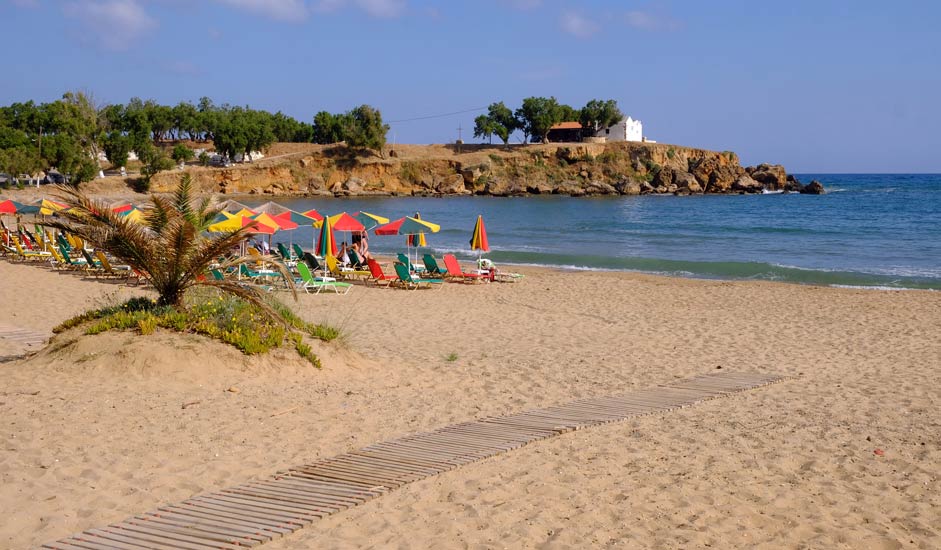
Agii Apostoli
The Agii Apostoli beach consists of two bays with a rugged peninsula in between. In addition to protecting the beaches from the wind, the peninsula provides a beautiful surrounding to wander around. In addition to sunbathing and swimming, you can go for a leisurely walk on the beach.
These sandy beaches are situated about 4 kilometers west of the city center and named after a nearby church. The beach has been awarded a Blue Flag, which means well-functioning services.
As is often the case in Crete, the beach areas consist of several beach sections next to each other - it's not always clear as to where the borders are. The Glaros beach, which is situated along the same beach stretch with Agii Apostoli, extends westwards almost reaching the small, public Blue Flag beach of Kalamaki.
Nea Chora
The first beach within walking distance westward from the city is Nea Chrora. This shallow sandy beach, mostly sheltered from the wind, is especially suitable for families with children. The beach is popular among locals and tourists alike due to its proximity and features - it is easily accessible for disabled people and services are at your fingertips.
Chrissi Akti
Chrissi Akti, the Golden beach, is situated some 3 kilometers away from the city. The name, the golden beach, refers to its golden sand. This Blue Flag beach is mostly protected from the wind. It is perfect for those looking for a quieter beach near the city, and especially for families with children due to the shallow water.
Beaches outside Chania
Stalos
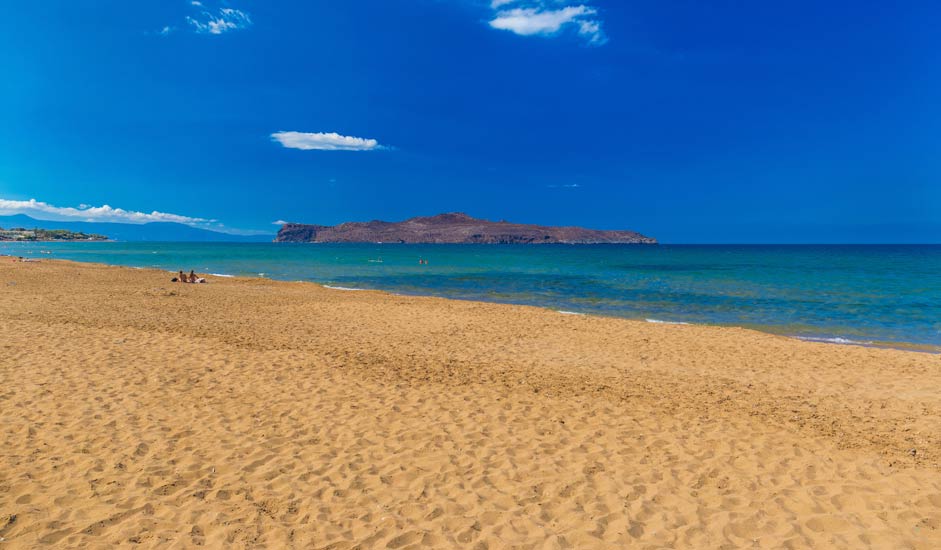
The Stalos beach is divided into two sections, Stalos and Kato Stalos. This popular, lengthy sand-beach is situated some 8 kilometers west of Chania, with plenty of choices of accommodation nearby, ranging from five-star hotel complexes to apartments. As per the requirements of the Blue Flag, all necessary services are available at the beach. If you don't have a car at your disposal, there's a local bus connection to the beach.
About a kilometer away from Stalos, there's another popular Blue-Flag beach, Agia Marina. This two-kilometer long beach with shallow water consists of fine sand, and it attracts turtles for nesting. The same applies for the Platanias beach, which is separated from Agia Marina by a small boat dock and a breakwater.
Platanias has merged from a small village into a residential suburb of Chania with urbanization and tourism going strong. Today, it is one of the busiest destinations with regard to both hotels and nightlife.
13 kilometers away from Chania, the Platania shoreline merges into Gerani. The sand of the Gerani beach is not as fine as that of Agia Marina or Platania, but also here you should be careful not to step on the turtles or their eggs. If you're looking for some peace and quiet, Gerani is not as busy as Agia Marina or Platania. Nonetheless, it has good services available.
Kalathas
The fairly quiet, shallow Kalathas sand beach is situated some eleven kilometers to the east. The Blue Flag guarantees that the beach is well maintained and has adequate services. There's a small island just outside the beach at a convenient distance to be reached by swimming. If you don't have a vehicle at your disposal, you can get there by bus.
Tersanas
The white-sanded small cove, Tersanas, is mostly protected from the strongest winds and the biggest waves. Due to its small size, this popular, Blue Flag beach may often seem crowded. It is situated some 13 kilometers east of the center, accessible by bus directly from the center.
Stefanou
The Stefani beach, which is also referred to as the Devil's Harbor (Seitan Limani), is a small sandy bay surrounded by rugged scenery. The beach is located 22 kilometers northeast of Chania and can only be reached on foot. The path from the parking lot to the beach is difficult to walk. You should therefore wear proper shoes and take enough water with you.
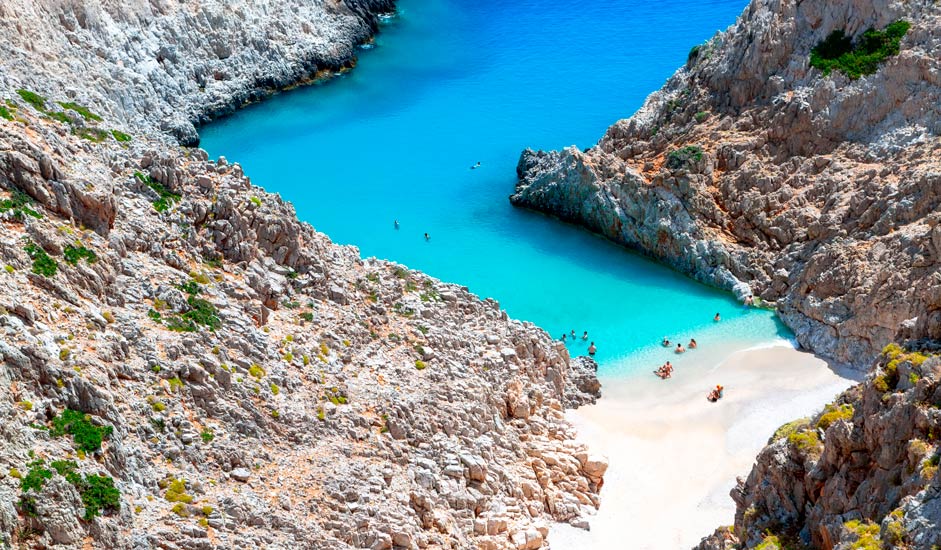
Maherida
This white-sand beach with deep water is situated inside a small rocky cove, and it is therefore sheltered from the biggest waves. The beach attracts nudists. You can reach the beach by the same bus that operates to Tersanas.
Stavros
The Stavros beach has two parts. The first more open section consists of coarse sand, and it is more susceptible to large waves. It is connected via a cape to another beach stretch with finer sand and a view that is dominated by Mount Vardies. Together with the cape, the second beach section forms a lagoon-like beach area that is sheltered from the wind. The cape in between contains the remains of an old quarry from the Venetian era.
The other part of the beach is legendary and considered the main beach area with regard to the Blue Flags. In addition to its beauty, the beach is famous of the 1960s movie, Zorba the Greek, as some scenes were filmed in a cave just some 700 meters from the lagoon. You can climb to the cave and admire the view to the sea and to Chania.
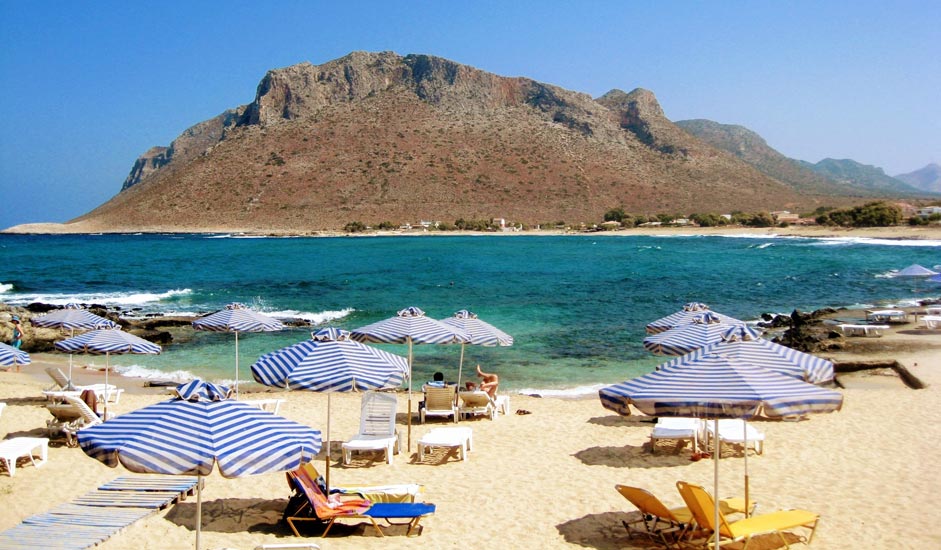
Balos
This shallow lagoon with clear water is certainly one of the most famous destinations in Crete. It has been formed between the mainland and a small island called Tigani, which means "frying pan" in Greek. In addition to Tigani, the landscape is dominated by two islands, Imeri Gramvousa with an old fort, and Agria Gramvousa, which is impossible to land with a boat.
Balos is situated approximately 56 kilometers northwest of Chania in the municipality of Kissamos, one of the municipalities of the Chania regional unit. The site is a conservation area and part of the Natura 2000 project of the European Union.
The easiest way to get to Balos from Kissamos is by boat. With a car, there's a parking lot about a kilometer from the beach. You should wear good shoes for the walk, and it's not suitable for disabled people.
To protect the area, there's a small additional fee for using a car to get there. The road is not paved, and you should also beware that the car park may be full due to the popularity of the place. There are also direct bus connections from Chania.
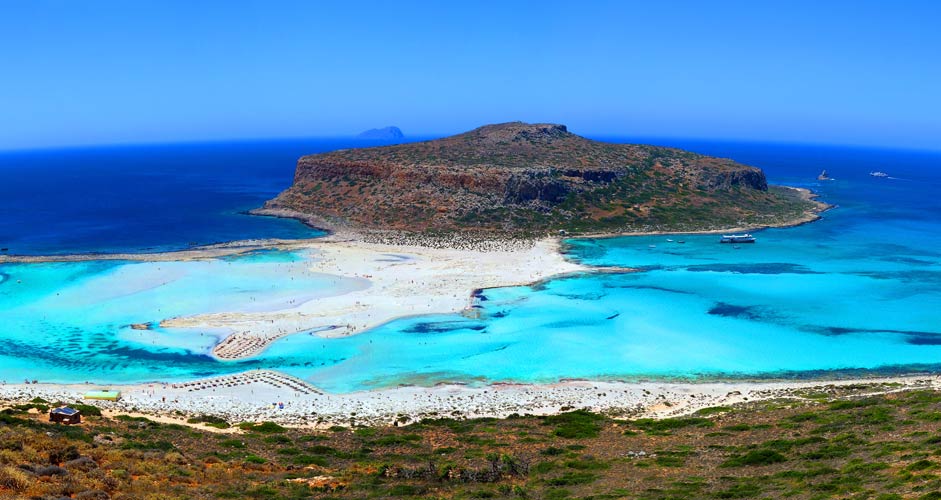
Elafonisi
The Elafonisi Beach is located at the southwestern tip of Crete, about 76 kilometers from Chania. Like Balos, it belongs to the municipality of Kissamos. Elafonisi is a popular destination with a direct bus connection from Chania.
Opposing the Elafonisi beach, the shore of the island of Elafonisi is located just 150 meters away. Due to the shallow water in between, it can be reached by wading through the water. Since the closest part of the island is actually a peninsula, it may seem like a separate island. The highest point of the island is 39 meters above sea level within the rocky part of the island.
However, the surface of the island consists mostly of sand and dunes. On both sides of the peninsula, there are exotic beaches with fine sand, some of which is pink due to the shells that have been crushed and ground into the sand over time.
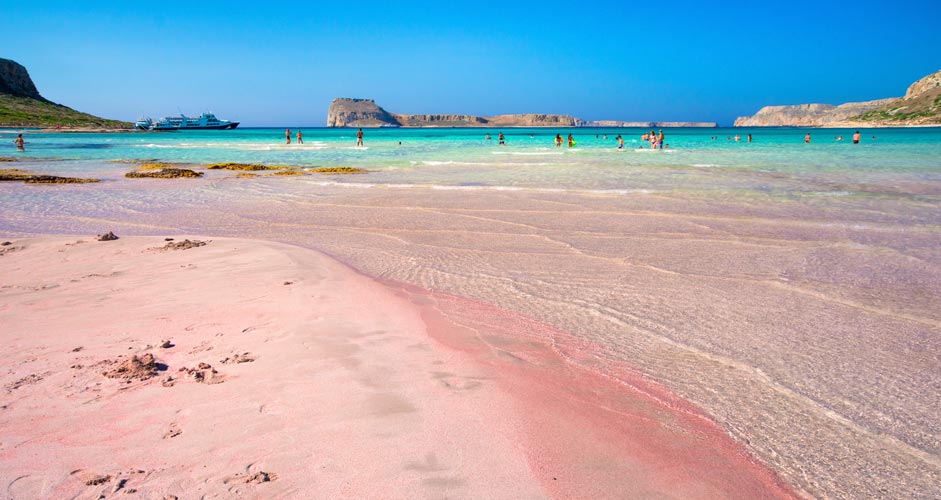
Elafonisi belongs to the Natura 2000 project. Due to its rare ecosystem, it is forbidden to take anything with you from the nature. Some very rare, endangered animals and plants have made the island their shelter. Overnight stays and camping are forbidden activities.
Chania – Attractions and things to do
Explore and admire the Old Town, the Old Venetian harbor, the docks, the Egyptian Lighthouse and much more. Fall in love with the city’s colors and beautiful details. Make your way to the foot of the lighthouse at the tip of the breakwater and enjoy the beautiful view over the city and the mountains in the distance.
The city’s scenery is dominated by lighthouse that was first built by the Venetians in the 16th century and later renovated by the Egyptians. The construction is known as the Venetian Lighthouse, and it is the oldest lighthouse in coastal areas of the Mediterranean.

Firka
This fortress was built by the Venetians for the purpose of preventing Crete from enemy attacks. The fortress is located northwest of the harbor, opposite to the famous lighthouse, offering a unique view over the Venetian harbor. The western side of the fortress merges with a section of an old Venetian wall from the Venetian era.
The entrance to Firka is situated next to the Cretan Maritime Museum. The museum provides insight into the long maritime history of the Cretans, starting from ancient times. Next to the Firka by the sea, there's also a small, park-like area called Talos.
Giali Tzamisi
Giali Tzamisi is the only Ottoman era mosque in the city that has remained until today. However, its function as a mosque has been ended, and the minaret has been destroyed. Today, especially in the high season, it is a common venue for various events and exhibitions.
Archaeological Museum of Chania
The archaeological museum of the city is situated next to the old harbor, and housed inside the old monastery, Agios Fragiskos. The collection includes items from the Minoan to the Roman eras, and there are findings from the ancient city of Cydonia as well. Read here for more information about the tickets and opening hours.
The Orthodox Cathedral
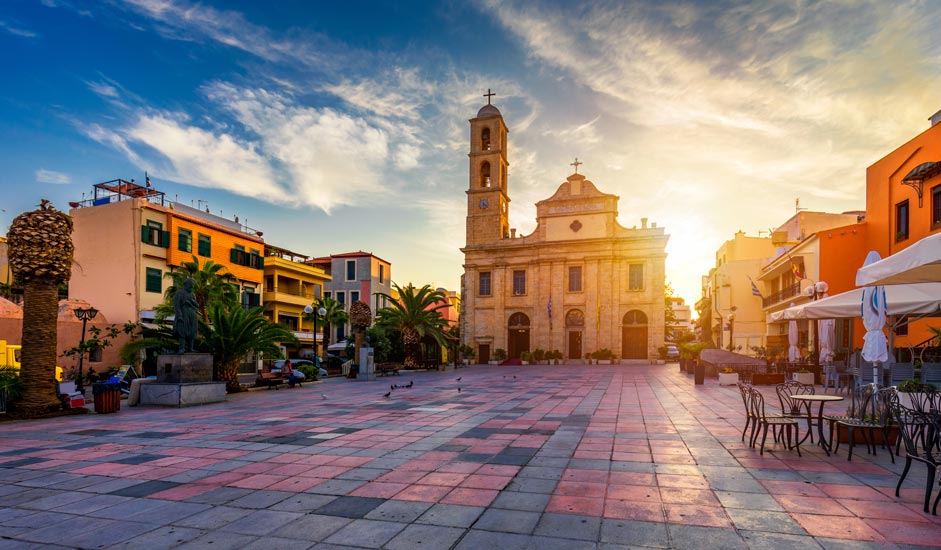
The Orthodox Cathedral in the city center, dedicated to the patron saint of Chania, St. Mary, was completed in 1860. It is located above the older 15th-century church that was ousted during the Ottoman rule.
Cydonia
Revealed by archaeological excavations, there are foundations of an ancient Cydonian city in the Old Town, almost at the heart of the city on the Kanevarou Street. Chania and its Old Town have been expanding on top it for centuries. Compared to, for example, Knossos or Phaestos, there's not very much left of Cydonia. The parts that have now been excavated were first revealed by the bombings of the World War II.
Next to Cydonia, there are ruins of the Venetian era fortress, Kastell, which was also under the control of the Ottomans.
Cretan House - Folklore museum of Chania
This is a privately owned, very small museum located in the Old Town. The museum is strongly recommended for anyone who's interested in tradition, history, crafts and art - and even if not passionate about these issues, why not stop by when walking past the museum? The ticket costs a few euros and you can buy definitely genuine local handicrafts.
Art Gallery - The Municipal Art Gallery of Chania
This art gallery is located on the border of the new town and the Old Town on the busy Chalidon Street, which leads directly to the Venetian harbor. There are Greek art and changing exhibitions on offer in the gallery.
Samaria Gorge
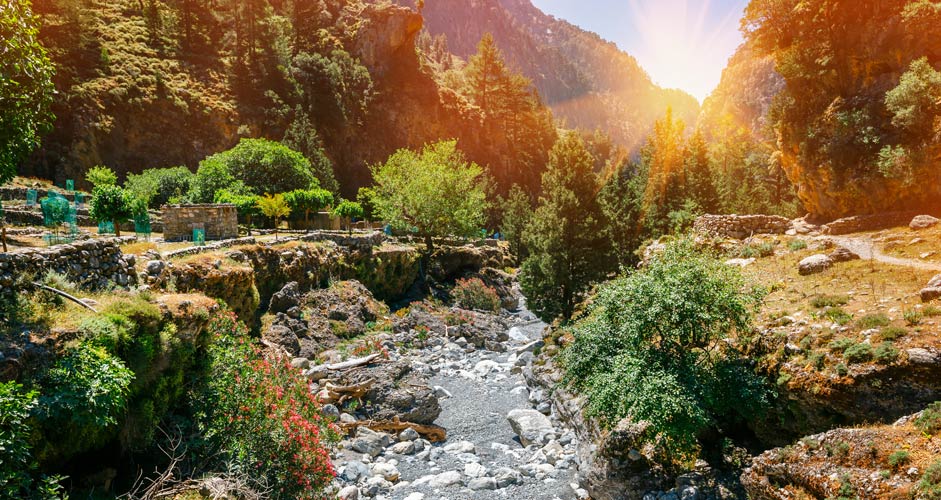
Samaria and the Samaria National Park are located in the Sfakia region of Chania. The gorge is one of the longest and deepest gorges in Europe with a marked hiking trail passing through. The route can be hiked in two directions - either by starting from the coastal village of Agia Roumel with a ferry connection from e.g. Loutro, or from the Omalos village at the northern end of the gorge with a bus connection from Chania. There is a small entrance fee of about five euros to the park.
The Church of Agios Nikolaos and its Minaret
The church is located on the outskirts of the Old Town, on the border of the new town in the Splantzia district – nearby, there's also a square that is called Splantzia. The Turks transformed the church into a mosque, and there's a minaret still remaining from the era. In the midst of the Venetian details, the minaret may come across as an architectural oddity.
The Museum of the Greek National Football Team
The Greeks have traditionally been a fanatic football nation, and already small children are sure to know which team they support.
The museum doesn't resemble a traditional museum, but rather a shop. Yet, it's worth a visit regardless of whether you're a football fanatic or not. The museum is located on the Tsouderon street, a stone's throw away from the Agios Nikolaos Minaret.
Ethnikos Kipos
Ethnikos Kipos is a park behind the market hall near the Football Museum. The park is popular among the locals as well, and many head to the green park to cool off after shopping and spending the day on the crowded streets. In the park, there's a cafe that was established already in the 20th century. It's a great spot to drink a cup of coffee with sweet treats. The park also has a large clock tower, one of the most famous landmarks in Chania.
The Museum of Elefterios Venizelos
Venizelos is a great man, a historical figure in Greece and Crete, who united Crete with Continental Greece. He also served as the Prime Minister of Greece seven times during his career.
Venizelos was born and buried in Chania. The museum is located in the Halepa district, less than five kilometers from the center and the Old Town. The Venizelos Tomb, situated less than three kilometers from the museum, is a popular destination both historically and due to its scenery. The birthplace of Venizelos is located in the village of Mournias near Chania.
Water Park Aqua Creta Limnoupolis
The water park, especially suited for families with children, is situated 8 kilometers outside the city in the Varipetro district. If you don't have a car at your disposal, there are bus and city train connections to the water park. The water park is only open in the high season, from May to late September. Tickets can be purchased online in advance, which may affect the price to some extent.
Food and drinks
The Old Town and the harbor are packed with restaurants and cafes, ranging from traditional kafenios, taverns and ouzerios to fine dining restaurants. Moreover, there are plenty of restaurants along the shoreline, especially aimed at fish lovers.
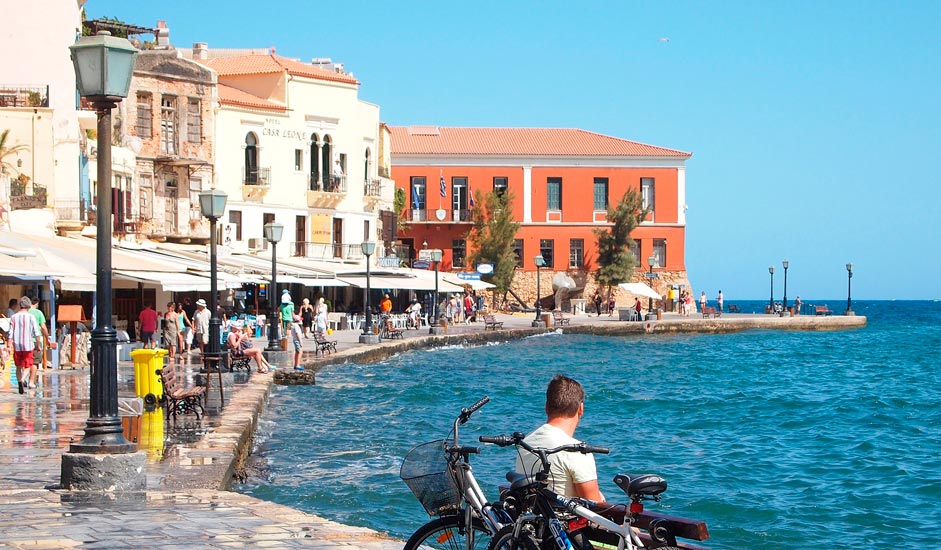
In Chania, try Chaniatiko Bourek, which is a zucchini-potato pie with mizithra cheese. Also try Tsigararia, consisting of a long-braised goat or sheep meat. In the past, this dish was made from Kri Cris, which is a nearly extinct wild goat in Crete. Kri is protected by law, and thus not allowed to be hunted.
Other great and rich dishes include kokkora, chicken stewed in tomato sauce; or pastitsio, Greek equivalent to macaroni casserole; or moussaka with horiatiki salad, mainly consisting of tomatoes, cucumbers, green peppers, onions, feta, oregano and olive oil.
Papoutsakia, the small shoes in English, filled with eggplant halves with a spicy minced meat mixture and creamy cheesecake, is yet another dish that will spoil your taste buds.
Shopping in Chania

Chania is divided into the Old town and a newer city area, Nea Hora. In the new town, there are shopping centers and other shops with most well-known brands well presented.
The streets of the Old Town are packed with shops ranging from tourist products to hippie clothing, beach bags and incense from the Far East. There are shops for all purposes, whether for crafts, cheese, clothing, ceramics, spices and herbs, jewelry, or cookware and ornaments made from olive wood. You'll have no trouble spending the entire day exploring the shops.
On the way to the Market Hall, stop by one of the Stivanadika stalls, known for its leather products, and buy for a souvenir of for yourself a high quality, most likely a handmade wallet, belt, bag or sandals.
Cretan knifes are popular souvenirs. The Sifaka Street, called Maheradika, is located in the Old Town. The street has long tradition among Cretan knife manufacturers. The market hall Kentriki Agora, which is a great experience just on its own, is located on the Tsouderon street.
Prices in Chania
The price level in Chania is quite affordable compared to the average in EU countries. Things that are important for tourists, such as accommodation, food and drinks in restaurants, are also cheap. Hotel prices will rise towards the high season.
Below, there are some examples of restaurant and hotel prices in Chania. Costs of hotel rooms are median prices at Booking.com.
Pizza in restaurant
33 cl beer in restaurant
Hotel room, 3-4* (April)
Hotel room, 3-4* (July)
€9-12
€3
€74
€110
Transportation
Local buses operate in two zones within the city. Make your own plans according to your transportation needs. The prices of tickets vary depending on where they’re purchased: from buses, kiosks or ticket machines.
Check schedules and prices via the webpage of the local transportation provider or download their application for Android or iOS:
How to get to the center from Chania Airport
The international airport of Chania, Agios Daskalogiannis, is situated some 14 kilometers away from the city area. To travel from the airport to the city, there are direct bus connections to the main bus station of Chania as well as taxis available. While a taxi ride cost almost 30 euros, the direct 30-minute bus connection to the center costs only 2,5 euros.
There’s a ferry connection operated by Anek Lines from the Chania harbor, Souda, to Piraeus in Continental Greece. For tickets and the prices, check the Anek Lines website. To get to the center from the harbor, there’s a local bus connection as well as taxis available outside the harbor.
Weather and when to travel
Just like the whole island, Chania is a suitable travel destination all year round. Bear in mind, however, that the island has its own peculiarities regarding the weather. Although Crete is a small and narrow island, it is big enough to contain areal weather zones, which change when traveling up and down or across the country.
The weather is also influenced by the mountains and, especially in the northern areas, the warm Meltemi Winds. On the other hand, the southern parts get their share of the Sirocco Winds from the Sahara Desert, which may also pick up sand and dust along the way.
The hottest and driest months are from June to August with the average daytime temperatures of 28-38 C. It is often cooler in the mountains than on the coast. The seawater temperature is also at its highest during that time. It is mostly warm and sunny between August and May, with the average daytime temperatures of 17-29 C. In October – November, the weather is similar.
In the winter, the precipitation is the highest between January and March, and the highest mountain peaks get a snow cover. The winter months, especially from late February to April, offer some fascinating views that should not be overlooked when planning when to travel. The prime travel season begins thereafter and lasts until early November.
---
Text: Angela M.
Photos: Adobe Stock & GNTO